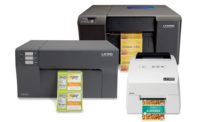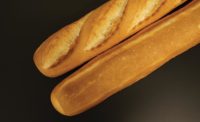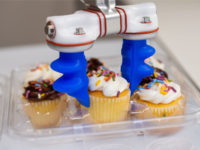The latest technological advances in label production provide bakery and snack producers with the flexibility to run a wide range of label sizes and types. New systems also enhance product appeal and better communicate information on food content. Areas of improvement include printers, labeling software, and marking/coding technology.
At the same time, the farm-to-fork movement continues to drive momentum for ingredient transparency on packaging. Consumers want to know what they are consuming for many reasons, such as the possibility of a product containing allergens, and to help ensure responsible sourcing. Products with clean packaging labels, clearly displayed, continue to find favor.
Millennials especially want to better understand their food, such as whether it’s natural or organic. Therefore, they’re eager to investigate food labels. Since a label typically has a limited footprint, some food manufacturers include QR codes, two-dimensional barcode that may include a link to the vendor’s website. This is only possible via precise label printing technology.
Digital advantages
While technological advances have improved printing speed, accuracy and flexibility across the board, on-demand digital printing is making steady inroads. “On-demand digital printing is one of the biggest trends in packaging overall, because it does not require significant changeover, as do offset or flexographic printing,” says Sean Riley, senior director, media and industry communications, PMMI, Reston, VA. “Digital printing allows brands to respond quickly to customer demands while improving the supply chain, reducing warehousing cost and waste, and enjoying a faster time to market.”
For manufacturers of labeling equipment, software, and supplies, success in the digital market depends on an ability to support a variety of packaging applications and develop products that can compete with the productivity of conventional equipment, while emphasizing the value-add that comes with digital.
“One of the biggest concerns regarding digital printing and labeling equipment is the initial cost. While using digital for bakery and snack foods offers differentiation in the market, the true transformation that it offers consumer packaged goods comes via the supply chain. Digital that is used in a targeted fashion for consistent, long-term, project-based work can reduce costs associated with transportation, warehousing, and obsolescence,” Riley adds.
Another major trend is high-speed digital inkjet printing, which allows users to run small quantities of packaging materials while making quick changes, or even personalization, according to Tom Spina, president and CEO, Luminer, Lakewood, NJ, a custom label manufacturer and converter. “These new systems produce high-quality print at high speeds, providing packaging suppliers with the flexibility to meet various marketing demands.”
Sophisticated servo technology in label printing equipment allows for more colors and, in the area of expanded content labels, more pages of information on an individual label. “The greatest flexibility can be achieved by combining digital inkjet with servo multi-web technology. Also, there continues to be significant improvements in traditional package printing capabilities, primarily in the area of flexographic printing,” Spina adds.
On-demand color label printing is a key market driver and that market share is increasing, according to Andrew Moore, product manager, commercial label printers, Epson America Inc., Long Beach, CA. “As baked goods businesses increase distribution through grocery and health food retailers and wholesalers, the dilemma of SKU proliferation intensifies. In addition, each distribution partner can require different packaging sizes and quantities, which further complicates labeling requirements. On-demand labeling can address these concerns, help lower operational costs and increase customer satisfaction.”
For example, Epson America’s line of ColorWorks desktop color label printers is designed to produce small batches in minutes. “The labeling software allows bakeries to comply with FDA, state and local regulations while providing traceability to meet auditing requirements. Together, desktop color label printers and software are capable of helping users meet production demands that were once limited to industrial label production,” Moore says.
Suppliers continue to work toward improving efficiency of labeling equipment. In 2019, ID Technology, a product brand from ProMach, Fort Worth, TX, introduced its CrossMerge label applicator module for print-and-apply labeling. The company notes that it’s ideal for high-volume secondary packaging lines. The new CrossMerge technology increases label output while simplifying mechanics and improving print quality and barcode readability. CrossMerge decouples print speed from line speed to simultaneously increase output and improve print quality. And by rotating the print head, CrossMerge optimizes the conditions for both barcode printing and label application.
Increased capabilities
Digital die-cutting also is being added to the mix of possibilities. Primera Technology Inc., Minneapolis, recently introduced the LX610 Color Label Printer/Cutter, a desktop printer with built-in digital die-cutting. It allows users to print short runs of labels in any size and shape, eliminating the need to purchase custom dies and wait for labels to arrive. “Users can design unique shapes and images that make their products really stand out at retail,” says Mark D. Strobel, vice president of sales and marketing.
Primera Technology also is developing a new edible ink printer. Designed for short runs, it prints with FDA-compliant ink directly onto cookies and other food items; no frosting sheets are required. A rotating carousel is integrated into the printer to keep production going while the operator can load/unload during the printing operation.
As part of this initiative, Primera Technology is working with government and industry groups to obtain compliance with a host of new regulations and recommendations. “For example, our edible ink printer will use GMP-certified ink. Made with FDA-approved ingredients in a GMP-certified facility, the ink will be filled in a certified clean room,” Strobel says.
Luminer produces extended content labels, multi-page booklets in a label format that allows for the inclusion of more information. Previously food packagers had to change their primary outer package or print different SKUs for the same item, Spina explains. “By using expanded content labels, the food company can react quickly to couponing needs, cross brand promotions, or informational content such as recipe’s, cooking procedures, or customer engagement.”
Thermal transfer
Videojet Technologies, Chicago, makes thermal transfer overprinters (TTO), which print ingredient lists and other product information directly onto labels and flexible packaging film. They are integrated into packaging machinery for intermittent or continuous-motion printing. In order to meet the demand for coverage of a larger printing area, the company has engineered an airless 107-mm TTO print head for its Videojet DataFlex 6530 thermal transfer overprinter.
The patented system can achieve print speeds of up to 1,000 mm/s and throughputs of up to 700 ppm, depending on the application and substrate, according to Chinaecherem Omenyinma, vertical marketing manager, Videojet Technologies. “The airless design helps to reduce operation costs, provide more control of the printhead movement, and increase throughput by 25 percent compared to previous Videojet TTO models. Operators don’t need to adjust the air pressure when trying to improve print quality.”
The newest Videojet TTO printers include Videojet iAssure technology, which automatically checks for code quality and position, and provides a warning when common code defects are detected. Operators can then decide whether to stop the line to correct the fault, thus reducing the need to scrap or rework product.
Brother Mobile Solutions, Westminster, CO, has introduced the TD line of four-inch desktop printers available in direct thermal and thermal transfer models. The printers produce readable, long-lasting labels that are needed to address the challenges of identifying and tracking items in a warehouse and across the manufacturing process, according to Mike Lowey, retail industry specialist. “In today’s speed-of-light business environment, inventory such as snack foods must move faster and be tracked efficiently to help producers minimize costs and stay competitive. These new-era labeling solutions can accommodate these demands.”
Looking ahead, Spina of Luminer sees a continuing trend toward the use of more synthetic, paper-like materials in label printing. “These products give the packaging designer and producer high-quality surfaces to print on just like glossy paper, but synthetic paper offers better durability and moisture resistance.”
Strobel says that inks continue to evolve not only for regulatory purposes, but also for flexibility and for new applications. For example, Primera Technology has developed a new pigment ink called Suva 11 for on-demand color label printers that is highly durable and works with more label stocks than other pigment inks.




